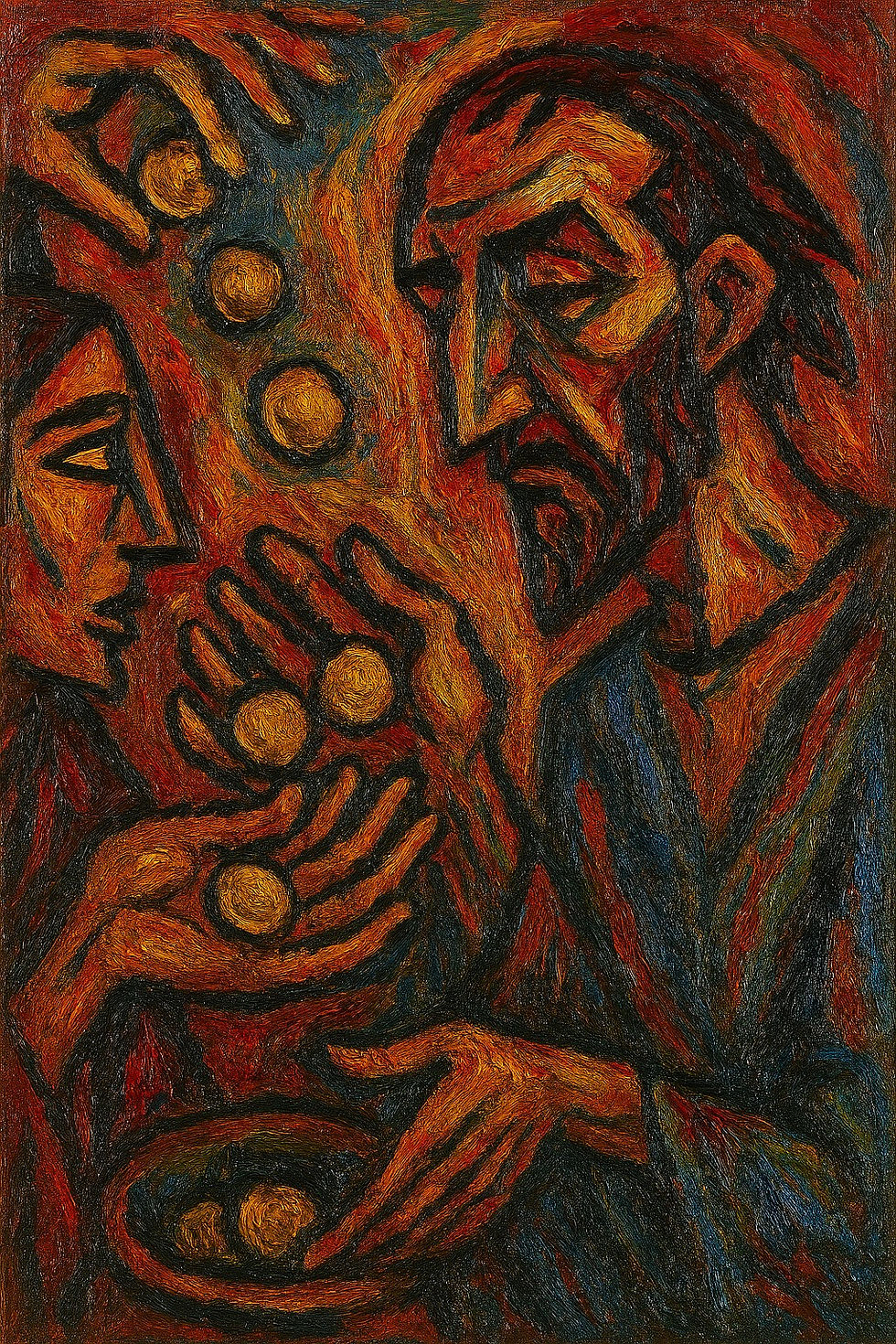Retina and Photoreception
- Martin Döhring

- 10. Okt.
- 5 Min. Lesezeit
Molecular mechanisms of information processing in the human retina

... below is a focused, step-by-step molecular walkthrough of how the retina converts photons into neural signals and extracts features (contrast, color, motion, luminance) before sending them to the brain.
1) Phototransduction in photoreceptors (rods vs cones) — the primary light → electrical transduction
Key idea: light converts 11-cis-retinal to all-trans-retinal inside an opsin, triggering a G-protein cascade that reduces intracellular cGMP and closes cyclic-nucleotide gated (CNG) channels → photoreceptor hyperpolarizes.
Steps and molecular players
Photon capture
Opsins (rhodopsin in rods; cone opsins — S/M/L — in cones) contain 11-cis-retinal (vitamin A aldehyde).
Photon → 11-cis → all-trans retinal → conformationally active opsin (R*).
G-protein activation
Active opsin activates transducin (G-protein): GNAT1 (rod) or GNAT2 (cone).
Transducin α subunit exchanges GDP→GTP.
Effector enzyme — PDE6
Transducin-GTP activates phosphodiesterase 6 (PDE6) (rod PDE6αβ with γ regulatory subunits; cones express PDE6C).
PDE6 hydrolyzes cGMP → GMP, reducing cytosolic cGMP.
Ion channel closure → hyperpolarization
Lower cGMP causes CNG channels (rod: CNGA1/CNGB1; cone: CNGA3/CNGB3) in the outer segment to close → fewer Na⁺/Ca²⁺ currents → outer segment hyperpolarizes (dark current reduced).
Hyperpolarization reduces tonic glutamate release at the photoreceptor synaptic terminal.
Amplification
One activated opsin can activate many transducins → very high single-photon amplification (rods >> cones).
Recovery / shut-off
Rhodopsin kinase (GRK1) phosphorylates R*, then arrestin (SAG) binds to block further transducin activation.
RGS9 complex (RGS9-1 + Gβ5 + R9AP anchor) accelerates GTP hydrolysis of transducin-α (turns it off).
Guanylyl cyclases (RetGCs) resynthesize cGMP; their activity is regulated by GCAPs (Ca²⁺-sensing proteins). When intracellular Ca²⁺ falls (light), GCAPs stimulate RetGC → cGMP restored.
Na⁺/Ca²⁺-K⁺ exchangers (NCKX) and PMCAs extrude Ca²⁺, coupling Ca²⁺ levels to feedback regulators (GCAPs, recoverin).
Net functional result: light → ↓cGMP → CNG closure → hyperpolarization → ↓glutamate release.
2) The visual (retinoid) cycle — pigment regeneration (molecular support for sustained vision)
After photoisomerization, all-trans-retinal is released and must be converted back to 11-cis-retinal.
RPE visual cycle (rods & cones): enzymes in the retinal pigment epithelium (RPE) — LRAT, RPE65, and CRALBP — convert all-trans retinol → 11-cis-retinal which returns to photoreceptors.
Cone pathway: cones also use a faster, partially RPE-independent cycle involving Müller glia, enabling rapid pigment regeneration for photopic vision.
3) Photoreceptor synapse — ribbon synapse and tonic release
Specialization: photoreceptors and many bipolar cells use a ribbon synapse for sustained high-throughput transmitter release.
Molecular features
Ribbon proteins: RIBEYE (CtBP-related), Bassoon and Piccolo organize a proteinaceous ribbon that tethers many vesicles.
Voltage-gated Ca²⁺ channels: Cav1.4 (CACNA1F) is the primary L-type channel in photoreceptor terminals; its open probability controls tonic glutamate release in the dark.
Release machinery: large readily-releasable pool, SNAREs and associated priming proteins adapted for continuous release.
Dark vs light: in darkness photoreceptors are relatively depolarized and continuously release glutamate; light hyperpolarization reduces release — this tonic vs reduced glutamate is what bipolar cells read out.
4) Outer plexiform layer — sign inversion and center responses
Synaptic triad: photoreceptor synapse onto bipolar cell dendrites and horizontal cell processes (lateral modulators).
OFF bipolar cells express ionotropic glutamate receptors (AMPA/Kainate). Photoreceptor hyperpolarization (light → less glutamate) causes OFF bipolars to hyperpolarize — they signal decreases in light (sign preserved).
ON bipolar cells use a metabotropic mGluR6 cascade (GRM6):
In darkness, photoreceptor glutamate activates mGluR6 → activates a G-protein (Gαo) cascade that closes TRPM1 (transient receptor potential channel), keeping ON bipolar hyperpolarized.
Light → less glutamate → mGluR6 inactive → TRPM1 opens → ON bipolar depolarizes (sign inverted).
Critical molecular partners: TRPM1, scaffold proteins like nyctalopin (NYX), and synaptic organizers (GPR179, etc.). Mutations → congenital stationary night blindness (CSNB).
Horizontal cells mediate the surround (lateral inhibition) that creates center-surround receptive fields.
Mechanisms of horizontal feedback include GABAergic release, ephaptic interactions, and pH-mediated modulation of cone Ca²⁺ channels — all act to modulate photoreceptor terminal Ca²⁺ and glutamate release creating spatial antagonism.
5) Inner plexiform layer — amacrine modulation and bipolar → ganglion signaling
Bipolar cells stratify in the IPL (ON layer vs OFF layer) and release glutamate onto ganglion cell dendrites and amacrine processes.
Amacrine cells (ACs) are extremely diverse (dozens of types). Key roles:
AII amacrine: central to the scotopic (rod) pathway — rod bipolar → AII → electrical coupling to ON cone bipolar (via connexin gap junctions, e.g., Cx36) and glycinergic inhibition to OFF pathway — routes rod signals into cone pathways for daylight circuitry.
Starburst amacrine cells: cholinergic + GABAergic, crucial for direction selectivity; localized dendritic Ca²⁺ transients and asymmetric GABA release onto direction-selective ganglion cells (DSGCs).
Other ACs provide temporal filtering (transient vs sustained responses), gain control, and oscillatory signals.
Synaptic plasticity / short term dynamics: vesicle depletion, presynaptic Ca²⁺ buffering, and modulation by neuromodulators (dopamine) shape temporal response properties.
6) Retinal ganglion cells (RGCs) — spike encoding and feature extraction
RGCs are the output neurons; they generate action potentials (voltage-gated Na⁺/K⁺ channels) and send axons through the optic nerve.
Different RGC types (parvocellular/midget, magnocellular/parasol, small bistratified, direction-selective, ipRGCs) encode distinct features:
Center-surround receptive fields: center from direct bipolar input; surround from horizontal/amacrine inhibitory circuits.
Direction selectivity: DSGCs combine asymmetric inhibitory input from starburst amacrines with specific excitatory inputs.
Color opponency: created by differential cone inputs to specific bipolar → RGC circuits (e.g., midget pathway for L vs M opponency; small bistratified for S vs (L+M)).
ipRGCs (melanopsin-expressing) contain melanopsin (OPN4) and can respond intrinsically to light (non-image functions — circadian, pupillary reflex).
7) Adaptation, gain control and modulatory systems (molecular mechanisms)
Calcium-mediated feedback in photoreceptors: intracellular Ca²⁺ falls in light → GCAPs activate RetGC → cGMP restored (partial recovery of current) → adaptation to background light levels.
Recoverin modulates GRK1 activity in a Ca²⁺-dependent way (slower kinetics in low light).
Bleaching adaptation: pigment availability and retinoid cycle speed limit sensitivity.
Neuromodulators: dopamine (from dopaminergic ACs) reduces electrical coupling (gap junctions) during daytime, altering receptive field sizes and contrast sensitivity; melatonin acts opposite at night.
Electrical synapses: connexin-based gap junctions (e.g., Cx36 in many inner retina electrical synapses) allow direct voltage sharing and are modulated by phosphorylation and neuromodulators.
8) Molecular specializations for color, motion and spatial processing
Spectral tuning: opsin amino-acid differences shift absorption peaks (L/M/S opsins: OPN1LW, OPN1MW, OPN1SW).
Opponent channels: wiring of cone outputs to bipolar cells and horizontal/amacrine interactions creates red-green and blue-yellow opponency at early stages.
Motion detection: starburst amacrines generate directionally tuned inhibition at the dendritic level; molecularly this depends on localized Ca²⁺ entry, asymmetric synaptic contacts, and precise receptor expression in DSGC dendrites.
9) Important disease links and molecular genetics (illustrative)
RHO (rhodopsin), PDE6A/B/C, GNAT1/GNAT2 → retinitis pigmentosa / congenital stationary conditions.
GUCY2D, RDH5, RPE65 → Leber congenital amaurosis / visual cycle defects (RPE65 gene therapy is a clinical example).
CNGA3 / CNGB3 → achromatopsia (cone CNG channel defects).
CACNA1F → X-linked congenital stationary night blindness (photoreceptor Ca²⁺ channel).
NYX, TRPM1, GPR179 → congenital stationary night blindness (ON pathway defects).
ABCA4 → Stargardt disease (retinoid handling in photoreceptors).
10) Concise summary flow (molecular chain)
Photon → opsin (11-cis → all-trans) → opsin*
→ transducin activation (GNAT)
→ PDE6 activation ↓ cGMP
→ CNG channels close → photoreceptor hyperpolarizes
→ ↓ tonic glutamate release at ribbon synapse
→ ON/OFF bipolar circuits (mGluR6/TRPM1 sign inversion for ON; AMPA/Kainate for OFF)
→ lateral modulation by horizontal & amacrine cells (GABA, glycine, ephaptic/pH, gap junctions)
→ RGCs integrate and spike → optic nerve → brain







Phototransduction in Photoreceptors: Rods vs. Cones – Molecular Details of Light-to-Electrical Signal Conversion
Phototransduction is the foundational process in vertebrate photoreceptors (rods and cones) where light energy is converted into an electrochemical gradient, initiating visual signaling. This occurs primarily in the outer segments of these cells, stacked disc membranes optimized for photon capture and rapid signaling. The key principle is a sign-inverting response: in darkness, photoreceptors are depolarized and release glutamate tonically; light hyperpolarizes them, reducing glutamate release, which then excites or inhibits downstream bipolar cells (BCs) to form parallel ON/OFF pathways.
Rods provide high-sensitivity, low-acuity scotopic vision (night vision), while cones enable color discrimination and high-acuity photopic vision (daylight). Both share a G-protein-coupled cascade but differ in kinetics, amplification,…